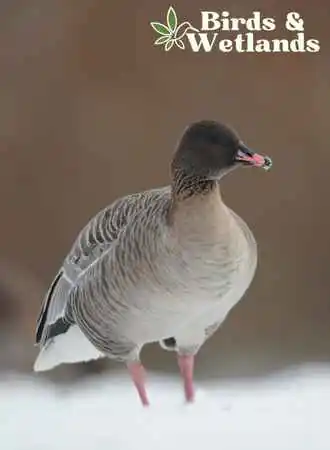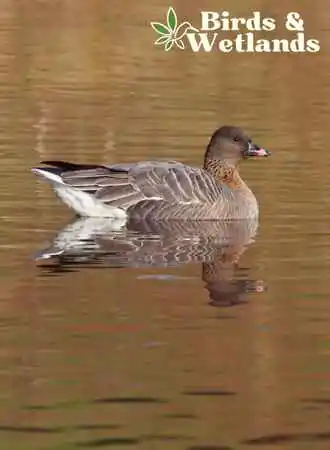Pink-footed geese are medium-sized goose species that are native to the tundra lakes and wet meadows of Greenland, Iceland, and Svalbard. The species is included in the subfamily Anserinae, within the family Anatidae. In addition to its notable size, this goose is also recognizable by its distinctive pink feet, which give it its common name.
Its binomial name comes from the Latin word Anser which means “goose” and ancient Greek brachus which means “short”.
Scientific Name: Anser brachyrhynchus
Height: 60–75 cm (24–30 in)
Wingspan: 135–170 cm (53–67 in)
Weight: 1.8–3.4 kg (4.0–7.5 lb)

Listen to the Pink-footed Geese
These geese are known for their high-pitched honking calls.
Description
Pink-footed geese have a dark brown head and pale mid grey-brown body. The rump, belly, and vent white, and the tail grey with a broad white tip. The upper wing coverts are a pale bluish-grey, similar to that of the greylag goose, and the flight feathers are blackish-grey.
The lower neck and breast of this short-necked goose are paler brown, and the flanks are darker brown with blackish-brown vertical streaks. An additional white line runs along the upper side, connecting to the goose’s white rump and belly. It has a short bill that is bright pink in the center with a black base and tip, as well as pink legs and feet.
Both male and female pink-footed geese have similar plumage, although males tend to be larger than females. Juvenile birds look similar to adults but are generally smaller and duller in color. Their upper parts have a heavier scaly pattern than their adult counterparts.

Diet
The diet of the pink-footed goose is primarily comprised of various plant materials, including leaves, stems, berries, sedge seed heads, mosses, and lichens. This herbivore also feeds on grains, vegetables, and grasses during the winter months. Additionally, before its migration, the pink-footed goose consumes high-energy foods like Empetrum berries to help fuel its flight. Thus, this goose relies primarily on a diet rich in plant matter to survive and thrive during different times of the year.
Habitat
The habitat of the pink-footed goose varies, ranging from fjords and rocky shores to open tundra and lowland farm fields. During the breeding season, this species chooses habitats with deep ravines and gorges that provide the necessary shelter from wind and cold.
In winter, many pink-footed geese head to lowland agricultural areas, where it can feed on the plentiful growth of grass and cereal crops. As this bird travels along its migration route, it has also been known to stop in fertilized grasslands or other areas with a ready supply of nutritious food.
The pink-footed goose leaves a huge carbon footprint. This is not due to bodily gas emissions, but rather to their grubbing for food in Artic soil, which releases carbon from the ground.

Range
Pink-footed geese are known for their long and impressive migrations, often traveling thousands of miles each year to reach their winter grounds.
When they leave the breeding grounds for their southbound migration, they do so from mid-September to early October, depending on weather conditions and other factors. Once they arrive at the wintering grounds, these geese form large flocks that travel together and reach migration speeds of up to 40-60 km/hour.
After spending several months in the winter grounds, these geese will return to their breeding grounds in mid-April or early May, with some flocks staying until mid-May. The families of similar birds stay together throughout this journey, from one end of the migratory cycle to another.
The pink-footed goose is a migratory bird with a relatively broad population range. It breeds in eastern Greenland, Iceland, north Atlantic and Svalbard, where it is considered the most common goose species.
During winter, pink-footed geese fly up to 40,000 birds in flocks to their wintering grounds in northwest Europe including Great Britain, the Netherlands, western Denmark and Belgium. Although these geese are a common sight in many parts of western Europe, only a few flocks spend winters in France and Ireland. However, some flocks have been sighted as far south as Morocco and the Canary Islands.
Additionally, rare vagrant flocks have been sighted almost always with Canada geese in some parts of North America, including Newfoundland, Pennsylvania and other regions in the East Coast.

Breeding & Mating
Pink-footed geese are known for their unique mating behaviors, which occur throughout the wintering areas and during migration. During these times, pairs typically form as individuals prepare to begin their journey toward the breeding grounds.
Once they reach their breeding sites, these geese begin engaging in courtship displays directed only toward their chosen mate. These displays help to cement the pair bond between the two birds and can include everything from exaggerated posturing and vocalizations to complex dances that incorporate both partners.
Although there is evidence of some western populations being monogamous, the relationships between male and female geese in other parts of their range are not entirely understood.
Pink-footed geese typically lay eggs in May in Iceland and late May to early June in east Greenland and Svalbard.
Nests for the pink-footed geese are typically located on cliffs or lake islets to provide protection against predators, often as part of loosely coordinated colonies with only ten pairs present at a time. Unlike many other geese types, the nest is typically just a scrape in the ground lined extensively with down feathers and other soft plant materials rather than a more elaborate structure.
The female goose typically lays between 3 and 6 eggs at one-day intervals, which it then incubates alone over 25-28 days. During the entire incubation period, the male goose acts as a guard, protecting the female from potential threats while she attends to the needs of her developing young.
Once hatched, the pink-footed goslings are precocial and cared for by both parents until they are fully fledged around 50-60 days later. The goslings usually accompany their parents on foot to the nearest lake.

Population & Conservation
Today, the global population of pink-footed geese is estimated to be around 280,000 individuals. Despite their high numbers, wildlife conservationists are concerned about their future prospects. This dwindling population is due to several factors, including habitat loss and degradation caused by human activities, illegal hunting and changes in climate and local weather conditions that impact migration routes and food sources.
Given this context, the conservation status of pink-footed geese is categorized as Least Concern today; however, there is growing concern that these birds may not be able to endure current pressures in the long term.

Key Takeaways
Pink-footed geese are named after their pink feet.
These are primarily herbivores, preferring to feed on plant materials such as seeds and grains.
Humans remain the main threat to these geese which has seen a declining population over the past decade.


